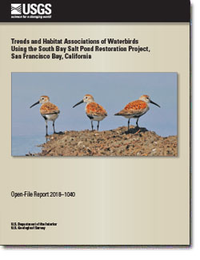The aim of the South Bay Salt Pond Restoration Project is to restore 50–90 percent of former salt evaporation ponds to tidal marsh in San Francisco Bay. However, hundreds of thousands of waterbirds use these ponds over winter and during fall and spring migration. To ensure that existing waterbird populations are supported while tidal marsh is restored in the Project area, managers plan to enhance the habitat suitability of ponds by adding islands and berms to change pond topography, manipulating water salinity and depth, and selecting appropriate ponds to maintain for birds. To help inform these actions, we used 13 years of monthly (October–April) bird abundance data from Project ponds to (1) assess trends in waterbird abundance since the inception of the Project, and (2) evaluate which pond habitat characteristics were associated with highest abundances of different avian guilds and species. For comparison, we also evaluated waterbird abundance trends in active salt production ponds using 10 years of monthly survey data.
We assessed bird guild and species abundance trends through time, and created separate trend curves for Project and salt production ponds using data from every pond that was counted in a year. We divided abundance data into three seasons—fall (October–November), winter (December–February), and spring (March–April). We used the resulting curves to assess which periods had the highest bird abundance and to identify increasing or decreasing trends for each guild and species.

